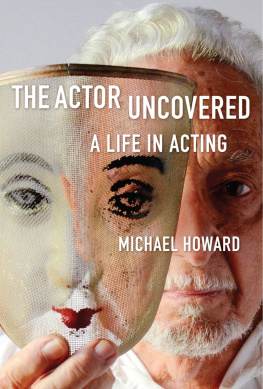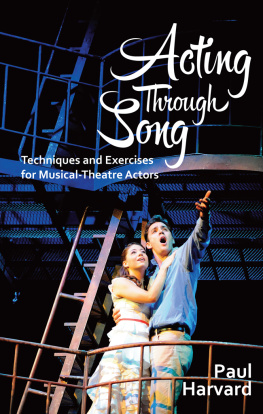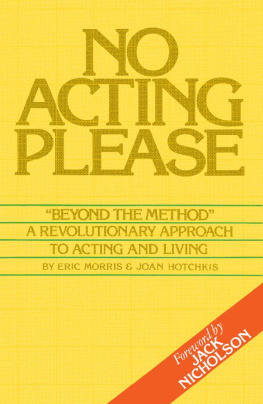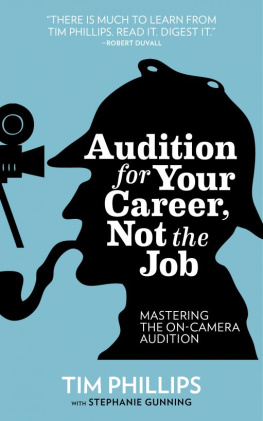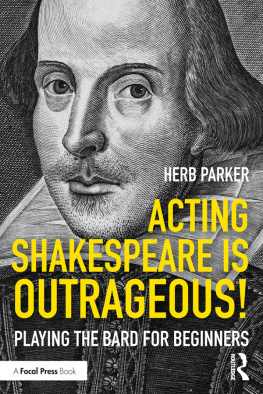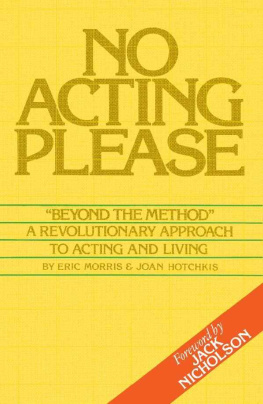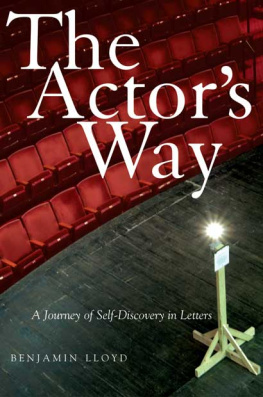C ONTENTS

D EDICATION
I would like to dedicate this book to the great teachers I studied with: Stella Adler, who taught me the absolute necessity for script analysis; Sanford Meisner, who forced me to understand what it was to be in the moment; Warren Robertson, who opened emotional doors and gave me my first chance to teach; Charles Nelson Reilly, who taught me the pure joy of facing an audience with no apology; David Craig, who heightened singing in the theater to a true art form; Tim Phillips, who opened my eyes to being more specific than I thought I could be; Sam Schacht, who brought me to the center of sensory work; Kenneth MacMillan, who taught me what intelligent support from a teacher can do to give an actor confidence; Jim Tuttle, who ignited my passion for acting when I was young and inexperienced; Patsy Rodenburg, who made Shakespeare leap off the page by teaching me how urgent his ideas become when performed with clarity and the right kind of focused physical energy; and my present voice teacher, Bruce Eckstut, who taught me the right technique and allowed me to sing freely and fully for the first time.
I NTRODUCTION:
D ISCOVERING THE D REAM
T he summer I was eleven years old, I rode my bike every Saturday in the blazing heat to the El Portal Theatre in North Hollywood for the first matinee. I couldnt wait to get inside the theater, where I knew I would be cool and buy my popcorn and sit, as I always did, on the aisle halfway down. I was always alone. I dont mean that as sad; I liked it; it was an adventure. I never knew what I was going to see and it didnt matter. I was in my world: the movies.
One Saturday, after the newsreel and coming attractions, an explosion hit the screenElia Kazans East of Eden, the story of a lonely outcast who desperately needed his fathers love, whose brother was the special one, whose mother had vanished. As the film continued, I saw this kids life, searching, desperate, heartbroken, mean, haunted, confused. I wasnt in a movie, I was in my life. I was this kid. He cried, raged, was romantic, weak, uncertain, vengeful, and ultimately, brave. When the movie ended I was shaking all over. It was freezing from the air conditioning, but that wasnt the reason I was shaking.
As I walked out of the theater in shock, I was hit with hundred-degree heat, and I almost passed out. I had just seen my life on the screen, but it wasnt my life, it was John Steinbecks, and Elia Kazans, and James Deans, and Julie Harriss, and Jo Van Fleetsgreat artists. I cried for days. I woke up in the middle of the night, every night. My heart was so full, I was so alive with ideas, and with hope. After that blistering day in North Hollywood, my life was never the same. I was connected to a dreamthe dream of becoming an actor.
When I was fifteen the explosion happened again, only this time it was in live theater. I read a review in the paper that said there was a searing performance by a brilliant New York actress that should not be missed. The reviewer seemed to be so excited by what he had seen that I felt propelled to get on a bus and take the long trek downtown to see The Far Country, starring Kim Stanley. The play is about the father of psychoanalysis, Sigmund Freud, and his discovery of the cause of hysterical paralysis. At the end of the second act, Freud tells a young woman that the reason she cant walk is that the night her father died, she did not go upstairs to give him the medication he needed because she was tired, and that somewhere within her she wanted him to die so that she could be free. Sitting in the front row of the theater, I watched Kim Stanleys cheeks turn bright red; then suddenly tears shot out of her eyes so fast and in such torrents that I clutched the edge of my chair. At that moment, the curtain started coming down as Ms. Stanley screamed with everything in her, No, its a lie! And when the curtain hit the stage floor, she continued screaming in the darkness.
Thirty seconds later they brought the house lights up, and the theater went mad. People started talking to each other, grabbing at each other, for they had just witnessed a great actress give a performance that didnt seem to be a performance at all but a trauma in a real persons life that we shouldnt be allowed to watch. And yet we were. Once again, I walked out of the theater in a complete daze. I was deeply moved by the characters journey and by Ms. Stanleys amazing performance, and I was overwhelmed with curiosity as to how a human being at a given moment could demand such intense emotions as Ms. Stanley did night after night.
The need to know how she did it kept haunting me and made me see every live theater production that Los Angeles had to offer during those years. And there were many, because, luckily, at that time the great theater actors, after making enormous hits on Broadway, traveled the country with their plays for at least a year. My experiences of watching great actors continued to excite me but they also confounded me, because it seemed incomprehensible to me that these actors could bring such powerful feeling, beautiful voices, fascinating physical behavior, and spontaneity to their performances on demand.
When I was nineteen years old, embarking on my life as an acting student, I went to an art museum in Washington, D.C. It was the first time Id gone to a museum on my own to observe paintings, and as I looked at the collection of Impressionists, I suddenly stopped in front of a Van Gogh, the first Id ever seen in person, and became transfixed. The painting was of a farmhouse with a rickety fence surrounding it. What amazed me, and seemed to awaken me, was that every slat of the fence was a slightly different shade of brown, from the lightest beige close to white to light brown to medium brown and on to the darkest brown close to black. I could not walk away. The fence seemed to be alive with energy and with what I realized later were the artists choices: Van Goghs impression of light and shadow, Van Goghs interpretation in color, texture, and form. Van Goghs simple fence spoke to me of transition and subtlety and boldness. I knew intuitively that what I was seeing was deeply connected to acting, but it took me years to understand exactly how.
At that point in my life, music, dance, film, theater, and literature had become my salvation, my lifes blood, my reason to live. I was all feeling, all desire, but with no concrete way to express all this drama within me. I had just begun to study voice, dance, acting, script analysis, and my own inner world. I became obsessed with learning; if there was a way to answer the questions I had about acting, I had to know it. After much tumult in my life, many mistakes, and much avoidance of responsibility, I finally learned that there were answers to my burning questions about acting as well as about life.
I want this book to help you in your journey as an actor. In it I have distilled the important techniques and tools that I learned and have taught in my thirty-two years as an acting teacher and coach, and that Ive seen work for many of my students who have gone on to have significant careers. Whether you are a beginner or a more advanced actor, I want to give you specific meat-and-potatoes ideas that you can bring to your work todayright nowas if you were sitting in my class and I was working with you directly. Some of the ideas are simple and some are more complicated. Read the book slowly and demand of yourself that you do all the tasks and the homework that I give you. Read the plays and watch the videos of the films I use as examples. Do the exercisesand do them as fully as you can. I promise you, it will pay off.
One of the most important things Ive learned about acting is that you cant separate how you live your life and how you practice your art. For that reason, Im also going to share with you what my life experience has taught me about aiming high and believing in yourself and not allowing anything or anyonenot even yourselfto stand in the way of your dream, which in Chapter Two youll find is your superobjective.
Next page


